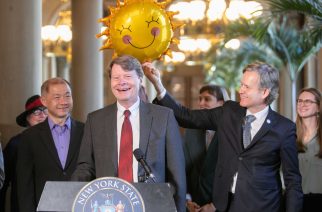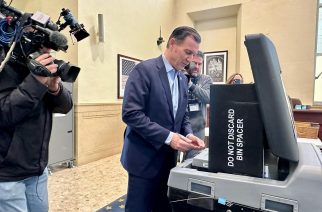
Gov. Andrew Cuomo and legislative conference leaders announced a $156 billion budget agreement late Thursday night, just three hours before the deadline established by the state Constitution. Highlights include continued funding for the STAR property tax relief program, a one-year tuition freeze at SUNY and CNY schools, $300 million for the Environmental Protection Fund, a phased-in minimum wage increase and a strong paid-family leave program.
Lawmakers are passing the budget bills Friday morning and are expected to finish by the weekend.
The 2016-2017 budget agreement being adopted this week includes spending in the following categories:
- Total State Operating Funds: $96.2 billion; 2.0 percent growth
- School Aid: $24.8 billion; 6.5 percent growth
- Medicaid: $18.5 billion; 3.4 percent growth under the cap
- Higher Education: $7.2 billion; 2.0 percent growth
“In a time defined by vitriolic hyper partisanship and when people have lost faith in their government’s fundamental ability to address the critical challenges of our time — in particular, the growing income inequality in our country, New York State has once again come together to get things done,” Cuomo said. “Many have proposed the big changes we sought — minimum wage, meaningful paid family leave, a balanced budget that caps spending and cuts taxes — but almost all have failed.”
Minimum Wage
For workers in New York City employed by large businesses (those with at least 11 employees), the minimum wage would rise to $11 at the end of 2016, then another $2 each year after, reaching $15 on 12/31/2018.
For workers in New York City employed by small businesses (those with 10 employees or fewer), the minimum wage would rise to $10.50 by the end of 2016, then another $1.50 each year after, reaching $15 on 12/31/2019.
For workers in Nassau, Suffolk and Westchester Counties, the minimum wage would increase to $10 at the end of 2016, then $1 each year after, reaching $15 on 12/31/2021.
For workers in the rest of the state, the minimum wage would increase to $9.70 at the end of 2016, then another .70 each year after until reaching $12.50 on 12/31/2020 – after which will continue to increase to $15 on an indexed schedule to be set by the director of the Division of Budget in consultation with the Department of Labor.
Further, the bill provides a safety valve to the increases. Beginning in 2019, the state budget director will conduct an annual analysis of the economy in each region and the effect of the minimum wage increases statewide to determine whether a temporary suspension of the scheduled increases is necessary. That analysis is submitted to the Department of Labor by the Division of Budget.
It is estimated that more than 2.3 million people will be affected by the increases in the minimum wage.
Paid Family Leave
The budget agreement includes what the Governor’s Office is calling the longest and most comprehensive paid family leave program in the nation. When fully phased in, employees will be eligible for 12 weeks of paid family leave when caring for an infant, a family member with a serious health condition or to relieve family pressures when someone is called to active military service.
Benefits will be phased in beginning in 2018 at 50 percent of an employee’s average weekly wage, capped to 50 percent of the statewide average weekly wage, and fully implemented in 2021 at 67 percent of their average weekly wage, capped to 67 percent of the statewide average weekly wage.
This program will be funded entirely through a payroll deduction on employees so it costs businesses nothing. Employees are eligible to participate after having worked for their employer for six months.
School Aid
The budget provides $24.8 billion in school aid, an increase of 6.5 percent for the 2016-17 school year.
School aid supports almost 700 school districts, and 2.8 million students in grades pre-kindergarten through 12.
New York schools already spend more per pupil than any state in the nation, at an average of $19,818, almost double the national average of $10,700.
In addition, the budget provides $340 million in annual funding for statewide, universal, full-day pre-kindergarten and continues the $2 billion Smart Schools program.
The budget fully eliminates the outstanding $434 million Gap Elimination Adjustment and Foundation Aid is increased by $627 million, or 4 percent.
The budget also includes $175 million in funding to transform failing schools and other high needs schools into “community schools.” These schools provide medical treatment, nutrition programs and other social services to students and their families to enable students in high-need area to learn while in the classroom.
The budget increases support for charter schools statewide by an estimated $430 per student and makes permanent the calculation of rental aid for New York City charter schools.
Infrastructure Spending
The budget includes more than $55 billion for transportation investments statewide, including $27.14 billion for State Department of Transportation and Thruway programs and $27.98 billion for the Metropolitan Transportation Authority programs. Over the next several years, spending on upstate and downstate transportation programs will reach a parity long sought by legislators.
The $27 billion DOT capital program includes: $21.1 billion for capital improvement of highways, bridges, rail, aviation infrastructure, non-MTA transit, and DOT facilities throughout the state.
This includes the launch of three new initiatives – BRIDGE NY, PAVE NY, and the Extreme Weather Infrastructure Hardening Program to further improve conditions on state and local roads and bridges, as well as provide resiliency to roadways that are particularly susceptible to weather events.
It also includes $4 billion for capital investment for a sixth year, and $2 billion in “Thruway stabilization” funding that will support capital improvements on the entire Thruway system and the New New York Bridge, allowing the Authority to freeze tolls on the system until at least 2020.
The $27 billion MTA Capital Program includes: $26.6 billion for improvement of capital facilities operated by the New York City Transit Authority, Long Island Rail Road, Metro-North Railroad and MTA Bus and major initiatives including $1.5 billion for Phase II of the Second Avenue Subway. Specifically, the budget authorizes a record $8.3 billion of state support for the program.









